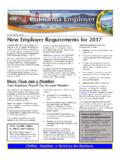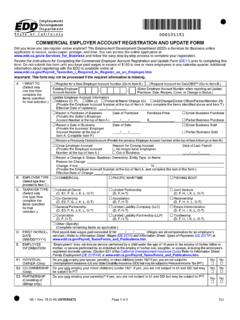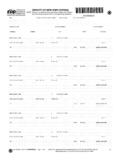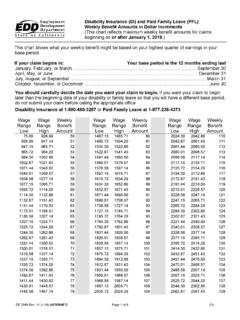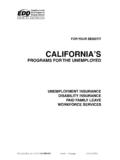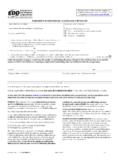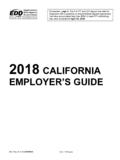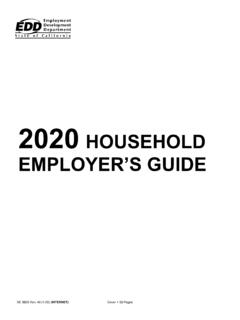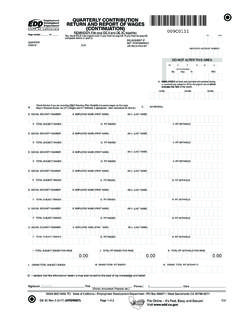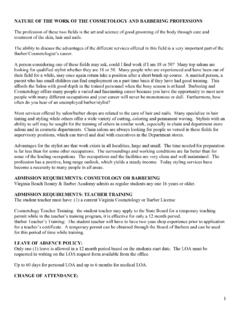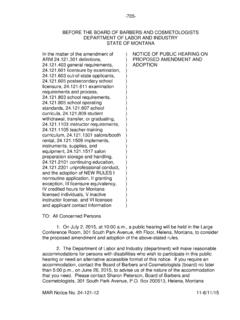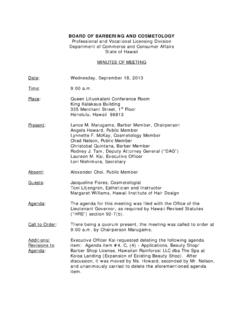Transcription of BARBERING AND COSMETOLOGY INDUSTRY - edd.ca.gov
1 BARBERING AND COSMETOLOGY INDUSTRYDE 231C Rev. 9 (6-16) (INTERNET) Page 1 of 6 CUThe purpose of this information sheet is to provide the BARBERING and COSMETOLOGY INDUSTRY with standards to be used when applying the common law rules of employment specifically to a professional licensed by the Department of Consumer Affairs, Board of BARBERING and COSMETOLOGY . This information is intended to clarify those circumstances under which this individual is an employee or independent Is a Licensed Professional?A licensed professional is an individual licensed by the Department of Consumer Affairs and includes, but is not limited to, barbers, cosmetologists, manicurists, electrologists, and Is a Principal?
2 A principal is defined as a COSMETOLOGY business operator or salon owner, or his or her agent or types of businesses in which the licensedprofessionals provide services include, but are not limited to:- Barber colleges - Facial salons- Barber shops - Hairdressers- Beauty and barber shops - Hair stylists, men combined - Hair stylists, women- Beauty culture schools - Manicure/pedicure- Beauty shops or salons shops- Clinics for skin care - Nail salons- COSMETOLOGY schools - Spas- COSMETOLOGY shops or - Unisex Hairdressers salonsEmployee or Independent Contractor?
3 Section 4304-1 of Title 22, California Code of Regulations (CCR), provides that to determine whether one performs services for another as an employee, the most important factor is the right of the principal to control the manner and means of accomplishing a desired result. Section 4304-12 of Title 22, CCR, provides standards to be used when applying the common law rules specifically to a professional licensed by the Board of BARBERING and COSMETOLOGY and is intended to make clearer those circumstances under which this individual is an employee or independent Professional Determination ElementsThe following Table of Determination Elements - BARBERING and COSMETOLOGY as provided in Section 4304-12 of Title 22, CCR.
4 Provides determination elements which shall be considered to determine whether a licensed professional is an employee or independent contractor with an explanation of the weight given to each element. Not all of the elements listed in the table need to be present to make a determination that a particular employee or independent contractor relationship exists. A determination of whether the services are being performed as an employee or independent contractor will depend upon a grouping of the elements present that are significant in relationship to the services being REQUESTA formal ruling may be requested by submitting a Determination of Employment Work Status for Purposes of State of California Employment Taxes and Personal Income Tax Withholding (DE 1870).
5 To obtain this form, access the Employment Development Department (EDD) website at or contact the Taxpayer Assistance Center at 888-745-3886. For moreinformation on the ruling request process, refer to the Information Sheet: Employment Work Status Determination (DE 231ES).ADDITIONAL INFORMATIONFor further information, please contact the Taxpayer Assistance Center at 888-745-3886 or visit your local Employment Tax Office listed in the California Employer s Guide (DE 44) and on the EDD website at Additional information is also available through EDD no-fee payroll tax seminars and online courses.
6 View the in-person and online course offerings on the EDD website at EDD is an equal opportunity employer/program. Auxiliary aids and services are available upon request to individuals with disabilities. Requests for services, aids, and/or alternate formats need to be made by calling888-745-3886 (voice) or TTY information sheet is provided as a public service and is intended to provide nontechnical assistance. Every attempt has been made to provide information that is consistent with the appropriate statutes, rules, and administrative and court decisions.
7 Any information that is inconsistent with the law, regulations, and administrative and court decisions is not binding on either the Employment Development Department or the taxpayer. Any information provided is not intended to be legal, accounting, tax, investment, or other professional OF DETERMINATION ELEMENTS BARBERING AND COSMETOLOGY ELEMENTS EVIDENCE OF EMPLOYEE INDEPENDENT CONTRACTOR WEIGHT (1) Policies or Rules, or Procedures of Conduct The principal establishes the policies, rules, or procedures of conduct that are followed by the licensed professional such as, prices, business hours, refunds, operating the cash register, work schedules, lunch breaks, attendance, dress code, customer complaint resolution, customer relations, and maintaining a concession of beauty products to the general public.
8 The licensed professional performs his or her services independent of the principal s policies, rules, or procedures of conduct. The licensed professional establishes his or her own hours of work, sets his or her own prices, directly collects payments from his or her customers, directly schedules his or her clients appointments, personally resolves any customer complaints related to his or her services, makes refunds to customers from his or her own funds, and determines his or her own manner of dress. The licensed professional is not required to sell the principal s retail items.
9 This element carries great weight. When the principal sets policies, rules, or procedures of conduct relating to the manner and means by which the licensed professional performs his or her services, it strongly indicates a right of direction and control. The right of the principal to direct and control the manner and means by which the services are performed is the primary test used to make an employment relationship determination. If that right exists, whether or not exercised, an employment relationship exists. Evidence that the principal does not have the ability to control the manner and means by which the licensed professional provides services is equally indicative of an independent contractor relationship.
10 (2) Supervision on the Job The principal supervises the licensed professional. The principal gives instructions that are followed by the licensed professional. The principal or its representative is on the premises to observe the licensed professional s services. The principal gives instructions to the licensed professional regarding general clean-up activities at the business facility. The principal assigns customers to the licensed professional. The principal reviews or evaluates the performance of the licensed professional by soliciting comments from customers.
